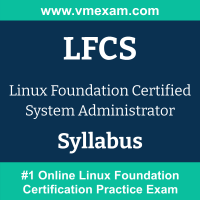 The Linux Foundation LFCS exam preparation guide is designed to provide candidates with necessary information about the System Administrator exam. It includes exam summary, sample questions, practice test, objectives and ways to interpret the exam objectives to enable candidates to assess the types of questions-answers that may be asked during the Linux Foundation Certified System Administrator (LFCS) exam.
The Linux Foundation LFCS exam preparation guide is designed to provide candidates with necessary information about the System Administrator exam. It includes exam summary, sample questions, practice test, objectives and ways to interpret the exam objectives to enable candidates to assess the types of questions-answers that may be asked during the Linux Foundation Certified System Administrator (LFCS) exam.
It is recommended for all the candidates to refer the LFCS objectives and sample questions provided in this preparation guide. The Linux Foundation System Administrator certification is mainly targeted to the candidates who want to build their career in System Administration domain and demonstrate their expertise. We suggest you to use practice exam listed in this cert guide to get used to with exam environment and identify the knowledge areas where you need more work prior to taking the actual Linux Foundation Certified System Administrator exam.
Linux Foundation LFCS Exam Summary:
|
Exam Name
|
Linux Foundation Certified System Administrator |
| Exam Code | LFCS |
| Exam Price | $445 USD |
| Duration | 120 minutes |
| Number of Questions | 17-20 |
| Passing Score | 67% |
| Recommended Training / Books | Linux System Administration Essentials (LFS207) |
| Schedule Exam | Linux Foundation |
| Sample Questions | Linux Foundation LFCS Sample Questions |
| Recommended Practice | Linux Foundation Certified System Administrator (LFCS) Practice Test |
Linux Foundation System Administrator Syllabus:
| Section | Objectives | Weight |
|---|---|---|
| Operations Deployment |
- Configure kernel parameters, persistent and non-persistent - Diagnose, identify, manage, and troubleshoot processes and services - Manage or schedule jobs for executing commands - Search for, install, validate, and maintain software packages or repositories - Recover from hardware, operating system, or filesystem failures - Manage Virtual Machines (libvirt) - Configure container engines, create and manage containers - Create and enforce MAC using SELinux |
25% |
| Networking |
- Configure IPv4 and IPv6 networking and hostname resolution - Set and synchronize system time using time servers - Monitor and troubleshoot networking - Configure the OpenSSH server and client - Configure packet filtering, port redirection, and NAT - Configure static routing - Configure bridge and bonding devices - Implement reverse proxies and load balancers |
25% |
| Storage |
- Configure and manage LVM storage - Manage and configure the virtual file system - Create, manage, and troubleshoot filesystems - Use remote filesystems and network block devices - Configure and manage swap space - Configure filesystem automounters - Monitor storage performance |
20% |
| Essential Commands |
- Basic Git Operations - Create, configure, and troubleshoot services - Monitor and troubleshoot system performance and services - Determine application and service specific constraints - Troubleshoot diskspace issues - Work with SSL certificates |
20% |
| Users and Groups |
- Create and manage local user and group accounts - Manage personal and system-wide environment profiles - Configure user resource limits - Configure and manage ACLs - Configure the system to use LDAP user and group accounts |
10% |
